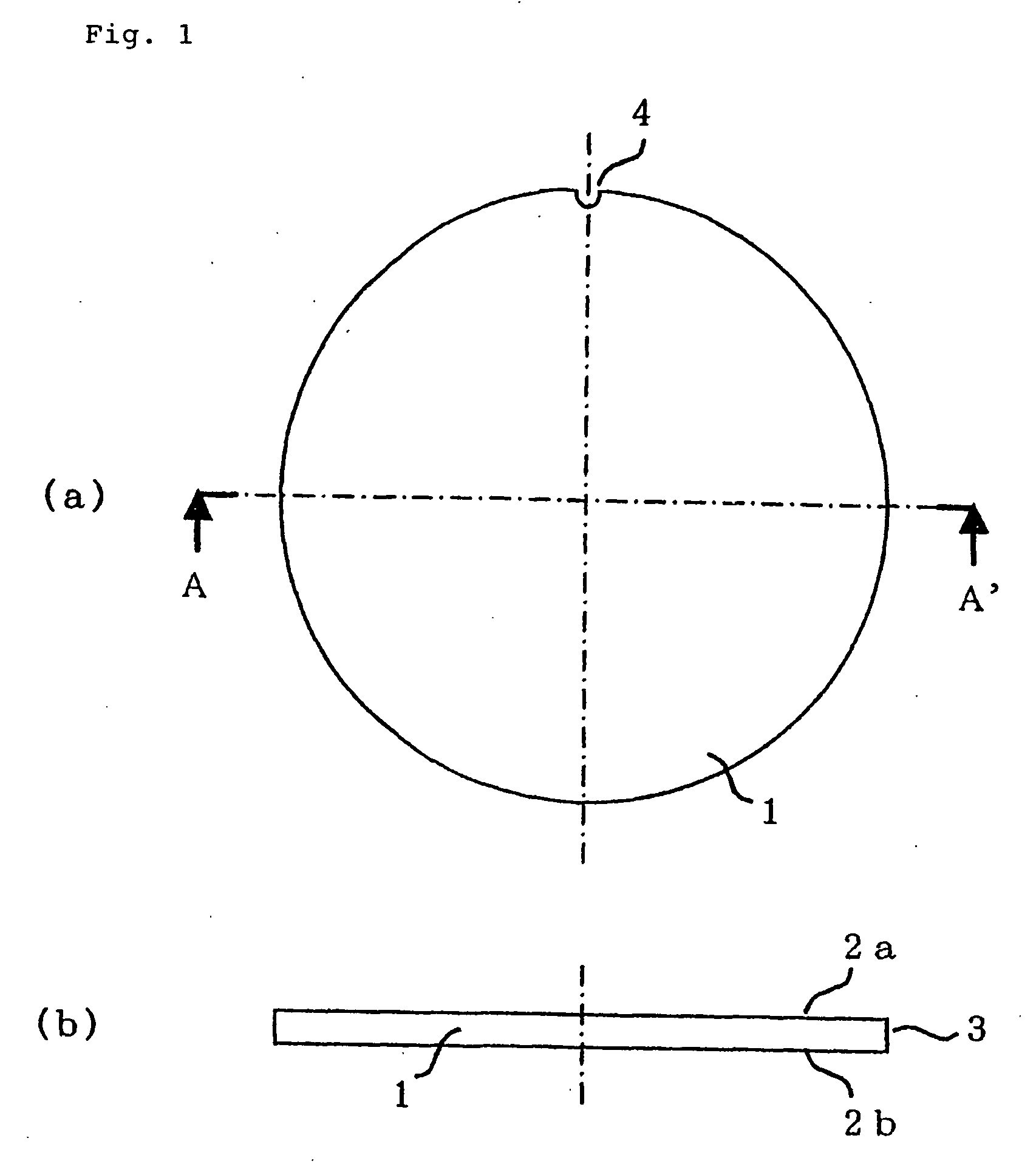Dummy wafer
a technology of dummy wafers and silicon chips, applied in the field of dummy wafers, can solve the problems of high cost and brittleness of silicon dummy wafers, inability to reuse, and difficult to respond to light sensors, etc., and achieve the effect of high strength and easy response to light sensors
- Summary
- Abstract
- Description
- Claims
- Application Information
AI Technical Summary
Benefits of technology
Problems solved by technology
Method used
Image
Examples
example 1
Lamination Forming of Dummy Wafer
[0125] A dummy wafer shown in FIG. 4 was fabricated using the procedures described below:
(1) Manufacture of Resin Composition for Composite Material
[0126] As a bis-phenol-A epoxy resin, 30 parts by mass of Epotohto YD 128 (trade name, manufactured by Tohto Kasei Co., Ltd.), as a phenol novolak epoxy resin, 50 parts by mass of Epotohto YDPN 638 (trade name, manufactured by Tohto Kasei Co., Ltd.), and as a phenoxy resin, 10 parts by mass of Phenotohto YP 50 (trade name, manufactured by Tohto Kasei Co., Ltd.) were mixed at 200° C. for 1.5 hours, and cooled to 90° C. To this mixture, 20 parts by mass of Epotohto YH 434 (trade name, manufactured by Tohto Kasei Co., Ltd.), which is a glycidyl-amine epoxy resin, and 40 parts by mass of 4,4′-diaminodiphenyl sulfone (DDS) (trade name: Seikacure S, manufactured by Wakayama Kasei Kogyou Co. Ltd.), which is a curing agent. are evenly mixed under a vacuum degassing to obtain a heat-resistant epoxy resin compo...
example 2
(1) Structure of resin composition for composite material
[0138] An epoxy resin composition was fabricated in the same manner as in Example 1.
(2) Fabrication of Dummy Wafer
[0139] There were used three kinds of unidirectional prepreg sheets: a unidirectional prepreg sheet obtained by drawing and aligning pitch-based carbon fibers having a tensile modulus of 500 GPa in one direction and impregnating them with the epoxy resin composition obtained in the above (1) (fiber mass per unit area: 50 g / m2, resin content: 38% by mass, thickness: 0.048 mm); a unidirectional prepreg sheet obtained by drawing and aligning pitch-based carbon fibers having a tensile modulus of 800 GPa in one direction and impregnating them with the epoxy resin composition obtained in the above (1) (fiber mass per unit area: 50 g / m2, resin content: 38% by mass, thickness: 0.048 mm); and a unidirectional prepreg sheet obtained by drawing and aligning PAN-based carbon fibers having a tensile modulus of 230 GPa in o...
example 3
(1) Manufacture of Resin Composition for Composite Material
[0152] An epoxy resin composition was fabricated in the same manner as in Example 1.
(2) Fabrication of Dummy Wafer
[0153] There were used three kinds of unidirectional prepreg sheets: a unidirectional prepreg sheet obtained by drawing and aligning PAN-based carbon fibers having a tensile modulus of 230 GPa in one direction and impregnating them with the epoxy resin composition obtained in the above (1) (fiber mass per unit area: 50 g / m2, resin content: 38% by mass, thickness: 0.052 mm); a unidirectional prepreg sheet obtained by drawing and aligning PAN-based carbon fibers having a tensile modulus of 380 GPa in one direction and impregnating them with the epoxy resin composition obtained in the above (1) (fiber mass per unit area: 45 g / m2, resin content: 38% by mass, thickness: 0.047 mm); and a unidirectional prepreg sheet obtained by drawing and aligning PAN-based carbon fibers having a tensile modulus of 230 GPa in one...
PUM
| Property | Measurement | Unit |
|---|---|---|
| Temperature | aaaaa | aaaaa |
| Fraction | aaaaa | aaaaa |
| Fraction | aaaaa | aaaaa |
Abstract
Description
Claims
Application Information
 Login to View More
Login to View More - R&D
- Intellectual Property
- Life Sciences
- Materials
- Tech Scout
- Unparalleled Data Quality
- Higher Quality Content
- 60% Fewer Hallucinations
Browse by: Latest US Patents, China's latest patents, Technical Efficacy Thesaurus, Application Domain, Technology Topic, Popular Technical Reports.
© 2025 PatSnap. All rights reserved.Legal|Privacy policy|Modern Slavery Act Transparency Statement|Sitemap|About US| Contact US: help@patsnap.com



